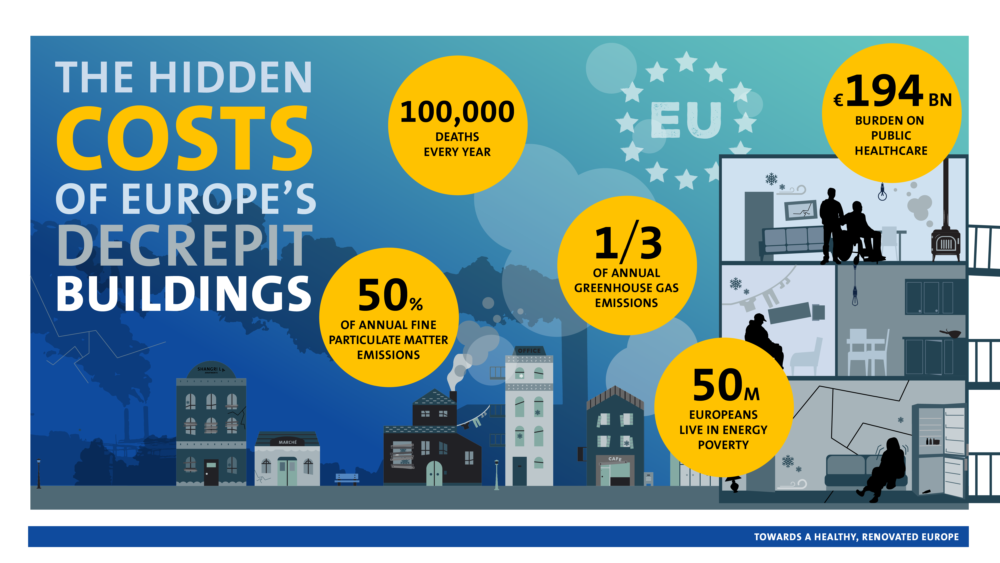The hidden costs of Europe’s decrepit buildings
Europe’s buildings are among the biggest contributors to the climate crisis, as well as health inequality, but to date one of the least addressed. In Europe, buildings account for around 40% of all energy consumed, and 36% of greenhouse gas (GHG) emissions. More than seven out of ten buildings are energy inefficient. The vast majority (85-95%) of buildings standing today will still be in use in 2050, when the EU aims to be climate neutral. Addressing the impact of buildings is thus a key challenge. Failure to take action on the threat of climate change could result in losses for Europe of €240 billion every year by the end of the century.
Decrepit buildings also contribute to air pollution – adding over half of the primary emissions of fine particulate matter (PM2.5) to the air – harming everyone’s health and wellbeing. Nearly 400,000 premature deaths every year in the EU are attributed to chronic exposure to PM2.5. The dramatic health consequences result in huge welfare losses, greater healthcare spending and lower productivity, generating economic losses of up to half a trillion euros per year.
There is also a dire social cost to inefficient and polluting buildings. With damp and leaky homes identified as one of the root causes of energy poverty, COVID-19 has only increased the pressure. Over 50 million people cannot sufficiently light, heat or cool their homes across Europe, with inadequate housing linked to 100,000 premature deaths annually. The economic burden of inadequate housing amounts to over €194 billion per year in public health costs.
Renovating the European building stock is a matter of social, environmental and economic urgency.
The multiple benefits of renovated buildings in Europe

Deep energy renovations, coupled with the move towards 100% renewable energy, are key to harness the multiple environmental, economic and social benefits that stem from a highly energy-efficient and decarbonised building stock.
-
Environmental benefits: energy savings, lower GHG emissions, and improved air quality. Reducing emissions and air pollution ensures better public health outcomes while supporting Member States in meeting their climate and energy targets.
-
Economic benefits: lower energy bills for people, increased innovation and competitiveness for the construction industry, strengthened energy security and new employment opportunities. By 2030 an additional 160,000 green jobs could be created in the EU by investing in energy efficiency. Depending on the levels of investment, increasing building renovations could create some 760,000 – 1,480,000 new jobs.
-
Social benefits: improved societal wellbeing thanks to healthier homes and offices, and improved productivity. Energy efficiency is also key to alleviate energy poverty. For every 1% increase in the energy efficiency targets, 7 million people can be lifted out of energy poverty. Renovations are an investment in people’s health, as they provide huge savings on healthcare and welfare costs, amounting to over €9 billion per year.
Overall, the total amount of monetised environmental, social and economic benefits linked to making Europe’s decrepit buildings energy efficient are estimated at up to €291 billion per year.
What is needed

Energy renovation stands out as the only option to improve Europe’s inefficient and polluting buildings, with massive benefits to the environment, health and society – while generating millions of green jobs. However, the current pace of renovations is too slow to fully decarbonise the building sector in line with the climate neutrality objective. To achieve this win-win-win, Europe needs to increase the annual rate of renovations to at least 3% and promote deep renovations that maximise the energy savings. To this end, mandatory minimum energy performance standards (MEPS) complemented with social measures and adequate technical assistance already in use in many countries worldwide, are the most effective policy tool to steer the sector and reap all the benefits. MEPS ensure the worst performing buildings are brought up to high-efficiency levels, while alleviating energy poverty when properly implemented in the residential sector. MEPS should be progressively phased in with the aim to cover all buildings, and complemented by an enabling framework that prioritises funding and financial support for the most vulnerable households.




